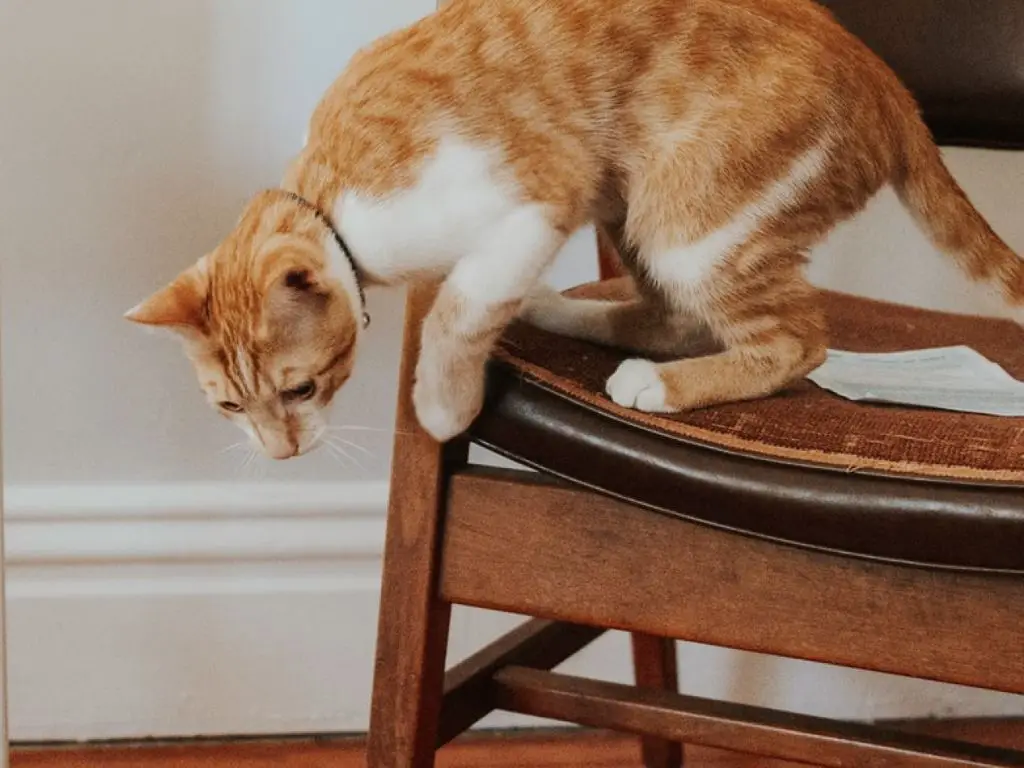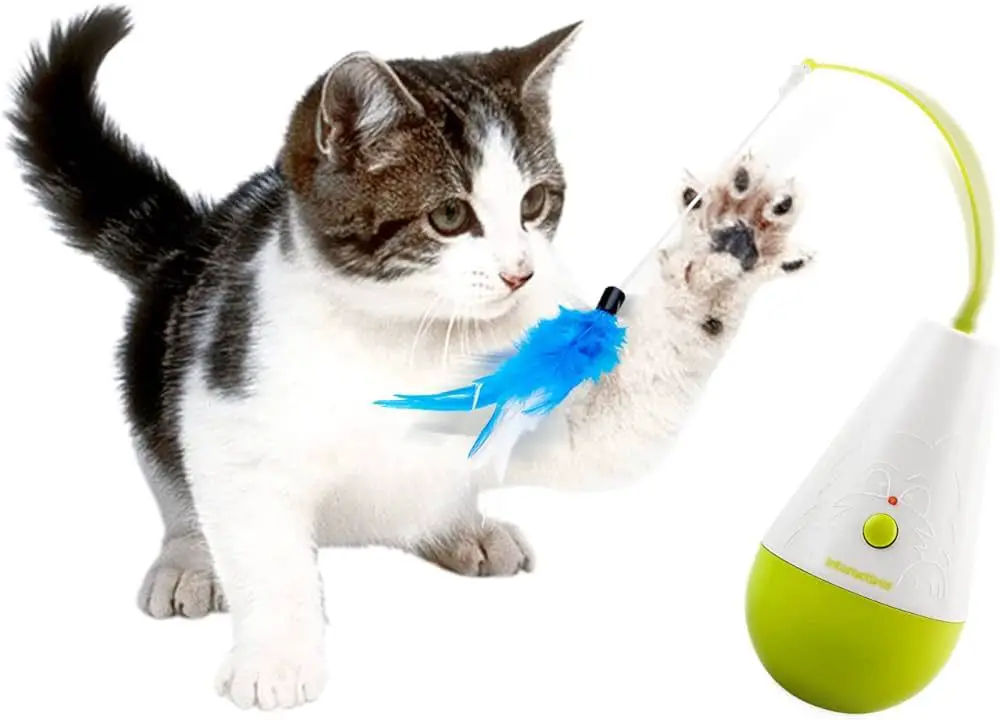What Are Cat Zoomies?
Cat zoomies refer to a sudden burst of frantic energy and activity from your cat. During a bout of zoomies, your cat will run around at top speed, jump on and off furniture, spin in circles, playfully attack objects, and often act in an excited, frenzied manner (1). This weird behavior typically only lasts for a few minutes at a time before your cat stops just as suddenly as they started.
The technical term for zoomies is “frenetic random activity periods” or FRAPs. Vets believe zoomies are a way for cats to release pent up energy and anxiety. Essentially, zoomies are your cat’s way of letting loose and getting their ya-ya’s out in a fit of gleeful cat craziness (2).
You’ll know your cat has the zoomies when they start sprinting, leaping, spinning, jumping on and off things, rolling around, and acting in an energetic, hyperactive way. It may look concerning, but zoomies themselves are completely normal feline behavior (3).
Why Do Cats Get the Zoomies?
There are several common theories for why cats experience zoomies:

Pent Up Energy – Cats sleep for the majority of the day, conserving energy for hunting and other activities. When they have gone a while without expending energy, it builds up and eventually needs an outlet. Zoomies provide a way for cats to release all their pent up energy in bursts of frantic activity and playfulness (source).
Playfulness – Zoomies are often interpreted as feline play behavior. Cats, especially younger cats, like to run, jump, and play. Zoomies allow them to engage in playful, entertaining antics and work off energy at the same time (source).
Happiness – Some experts believe zoomies are an expression of sheer joy and excitement in cats. After sleeping or resting, cats may be overwhelmed with happiness and energy, resulting in a burst of zoomies as a way to channel their emotions (source).
Are Zoomies Normal for Cats?
Zoomies are perfectly normal behavior for cats of all ages, breeds, and backgrounds. According to veterinarians and animal behaviorists, zoomies are simply bursts of energy and joy that cats experience sporadically.
Essentially, when cats get the zoomies, they are racing around the house at top speed, jumping on and off furniture, spinning in circles, rolling on the floor, and playfully running into owners and other pets. While the intensity and duration varies, most cats will experience these energetic outbursts from kittenhood into their senior years.
As stated by Four Paws (https://www.fourpaws.com/pets-101/cat-corner/cat-zoomies-explained), zoomies stem from cats’ natural instincts to hunt, chase, and capture. They typically happen when cats build up excess energy or excitement that they need to burn off. So for healthy cats, zoomies are an entirely normal way to release pent-up energy and ease stress.
While the zooming, crashing, and crazed play may seem concerning, it is very rare for cats to hurt themselves during these energetic episodes. As long as the zoomies occur sporadically and your cat seems relaxed afterwards, they are nothing to worry about. In fact, regular but infrequent zoomies are a sign your cat is active, stimulated, and content.
When Should Zoomies Concern You?
While occasional zoomies are totally normal for cats, excessive or prolonged zoomies may be a sign of an underlying issue.
According to Fetch Pet, you should contact your vet if your cat’s zoomies start happening daily or last for hours at a time. Frequent zoomies can indicate boredom, lack of exercise, or stress.
Cats may also get the zoomies when in pain or dealing with illness, as noted by Four Paws. Conditions like hyperthyroidism, liver disease, and cognitive dysfunction can cause zooming, meowing, and disorientation in senior cats. Sudden increased zoomies in an older cat warrants a veterinary visit.
Additionally, Cats Protection says to watch out for destructive zoomies where your cat starts scratching furniture or causing property damage. This type of zooming may indicate stress, anxiety, or frustration in your cat.
If your cat’s zoomies seem aggressive, compulsive, or go on for longer than 10-15 minutes, consult your veterinarian to rule out any medical issues. With the right care and enrichment, zoomies can go back to being a harmless quirk in an otherwise happy, healthy cat.
Encouraging Healthy Zoomies
Zoomies are a natural behavior for cats to release pent-up energy. While zoomies can seem disruptive, you can encourage healthy zoomies in your cat by providing proper outlets for their energy and play needs. This will give your cat an appropriate channel for their zoomies.

Be sure to play with your cat regularly throughout the day using interactive toys like feather wands and laser pointers. Have multiple short 5-10 minute play sessions rather than one long session. Place toys around your home so your cat has access when they feel energetic. Provide ample high places like cat trees, shelves, and window perches for climbing and exercising. Consider installing a catio or cat enclosure so your cat can play outdoors safely.
Try to tire out your cat before bedtime zoomies with late evening play. Feed your cat their main meal at night since a full belly may lead to sleep rather than zoomies. Provide puzzle feeders and treat balls so your cat has to work for their food. This mental stimulation can help curb zoomies. Always ensure your cat has access to water to stay hydrated after zoomie sessions.
With proper outlets, most cats naturally have fewer and shorter zoomie bursts. But do supervise play and provide reinforcement to encourage positive behaviors. This will help make zoomies an enriching experience rather than a destructive one.
Zoomie Triggers and Prevention
One of the most common triggers for zoomies is boredom and excess energy. Cats are natural hunters and need active playtime and stimulation. Lack of play can lead to frustration and zoomies as an outlet. Make sure your cat has daily interactive play sessions with wand toys that allow them to pounce and chase. Rotating toys can keep things interesting. Provide puzzle feeders and hide treats around the house for mental stimulation as well. Avoid scolding or reacting harshly to zoomies, as this can inadvertently reward the behavior. Redirect to appropriate toys instead. Cats may also zoom after using the litter box, so providing extra litter boxes and cleaning often can help.
According to https://www.fetchpet.com/the-dig/cat-zoomies, zoomies can also be triggered by stress and changes in routine. Minimizing stressful events like moving homes, introducing new pets, or loud noises can prevent zoomies. Maintain consistent feedings, wake up times, and play sessions. Providing places to perch up high or hide can also make cats feel more secure.
Zoomie-Proofing Your Home
One of the biggest challenges of cat zoomies is preventing destruction around the home. When cats get the zoomies, they can leap, climb, and zoom around with little regard for decor or belongings. While zoomies themselves are normal cat behavior, the aftermath can be frustrating for owners. Luckily, there are some strategies to minimize zoomie damage.

Start by securing or removing any fragile decor and knickknacks. Pottery, vases, houseplants, and picture frames are prime zoomie casualties. Consider keeping irreplaceable items in closed cabinets or shelves during peak zoomie times. Remove dangling cords, curtains, or blinds that could be tempting zoomie toys.
For furniture, use non-slip pads under lamps, vases, and other items to prevent them from sliding off surfaces during energetic sprints. Avoid open shelves in favor of enclosed bookcases and storage bins. Securely mount TVs and screens high up on walls to avoid accidents.
Pet-proof screens and mesh over windows can protect both your cat and home from zoomy leaps. Install child safety locks on lower cabinets and doors to sensitive areas. Place scratching posts, towers, and approved scratchable surfaces around your home to redirect scratching from furniture.
Providing plenty of enrichment toys will also help satisfy your cat’s need to play and zoom. Rotate toys frequently to prevent boredom. Consider puzzle feeders rather than free-feeding to mimic natural hunting behaviors. Ensure your cat has places to perch up high to survey their kingdom.
While no home may be 100% zoomie-proof, these strategies can help safeguard your belongings. Understand zoomies are instinctual and aim to provide approved outlets for the behavior, rather than suppress it entirely. With some preparation, both you and your cat can happily coexist during bouts of the zoomies.
Exercising Your Cat
Regular exercise is important for your cat’s physical and mental health. According to WebMD, aim to play with your cat for 10-15 minutes at a time to get their heart rate up and release energy. If they seem bored or disinterested, it’s okay to end the play session.

There are many fun and stimulating ways to exercise your cat at home. EverydayHealth recommends activities like chasing laser pointers, batting at dangling toys, exploring puzzle feeders and treat balls, or running through cat tunnels or obstacle courses. You can also use interactive toys like feathers on strings or crinkle balls to engage their natural hunting instincts. Just be sure to monitor your cat to avoid overexertion.
Another great form of exercise is a cat wheel or treadmill, like the Catit Senses 2.0 Digger which allows them to run and dig at their own pace. Providing appropriate scratching posts and cat trees for climbing and stretching is also beneficial. The key is tailoring activities to your cat’s personality and abilities.
With daily playtime and exercise, your cat can maintain a healthy weight, improve joint mobility, release pent-up energy, and prevent boredom or destructive behaviors. As WebMD notes, “A tired cat is a good cat.” Satisfying their activity needs is part of being a caring cat owner. Just be attentive to your cat’s signals and don’t overdo it. A little bit of play goes a long way.
When to See the Vet
While occasional zoomies are normal for healthy cats, excessive or prolonged zooming may indicate an underlying medical issue. According to Hill’s Pet Nutrition, you should contact your vet if your cat’s zoomies are accompanied by other concerning symptoms like weight loss, changes in litter box usage, or unusual vocalizations.
Specifically, contact your vet promptly if your cat’s zoomies are coupled with:
- Lethargy or lack of interest in playing
- Decreased appetite or increased hunger
- Sudden weight loss or gain
- Excessive thirst or changes in water consumption
- Changes in litter box habits
- Unusual vocalizing or crying
- Aggression or irritability
These accompanying symptoms may indicate an underlying medical condition requiring veterinary attention, such as hyperthyroidism, diabetes, arthritis, dental disease, or cognitive dysfunction. It’s important to contact your vet promptly if you notice any persistent changes in your cat’s behavior, activity levels, or physical health.
Zoomies and Reddit
Cat zoomies are a popular topic on Reddit, with many cat owners sharing stories and seeking advice. Some popular Reddit threads discussing cat zoomies include:
In a thread on r/CatAdvice discussing if zoomies are normal for indoor cats, Redditor u/catperson94 commented: “Perfectly normal. You’re lucky it’s only in 5-10 minute bursts.” (Source)
On r/CatAdvice, Redditor u/FluffyCatPantaloons replied to a question about how often cats get zoomies: “My kitten is 5 months, I’d say between 2 and 3. Used to be more but she’s calmed a little bit. Although the zoomies can last a lot longer.” (Source)
In a discussion on r/CatAdvice, u/catsandplantsandcats responded to whether zoomies meant a cat was unhappy: “Absolutely not true. Zoomies means they are expending energy and are happy and lively and feel good. I’ve seen outdoor cats get zoomies too.” (Source)
